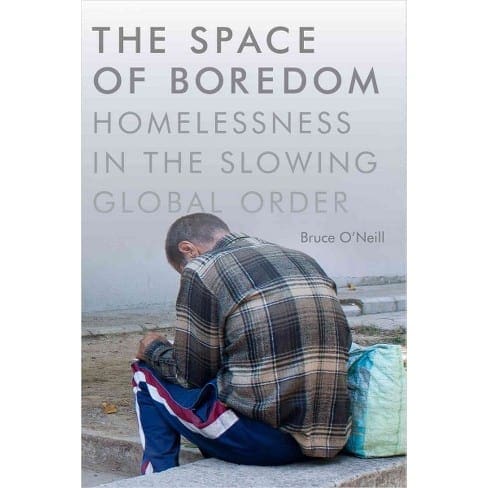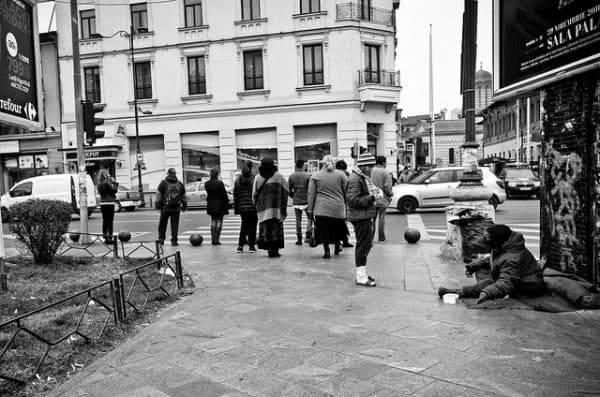The Space of Boredom takes us to spaces on the edge of new global orders, focusing on the lives and practices of homeless men and women left behind by globalization’s promises of accelerating connection and swelling opportunity. Anthropologist Bruce O’Neill focuses on the worlds of homeless Romanians who sense there is no place for them at these frontiers. Their experiences of boredom, by contrast, settle into the contours of days spent waiting in shelters or moving through the city on foot. O’Neill’s monograph unfolds in the drag of these boring durations and long walks.
The result is a conceptually rich ethnography that presents new and noteworthy ways of understanding globalization.
 The Space of Boredom does this by attending to the experiences of those who are not able to transit freely within the worlds globalization conjures. Ann Marie Thornburg talked with Bruce O’Neill about his monograph via email.
The Space of Boredom does this by attending to the experiences of those who are not able to transit freely within the worlds globalization conjures. Ann Marie Thornburg talked with Bruce O’Neill about his monograph via email.
AMT: What initially drew you to working in Romania (Bucharest)? How, specifically, did your focus on boredom come into view?
I came to anthropology as a doctoral student. My background was in urban geography (for my masters) and in sociology (for my bachelors), and I turned toward anthropology with thematic interests in cities and in inequality. It was while completing applications for anthropology programs that I found myself asked for the first time where in the world I wanted to ground my thought about urban inequality. I instantly gravitated towards Eastern Europe for a number of reasons, both biographical and historical: A child during the 1980s, the region held a certain Cold War mystique; its socialist past assured me that I would get to read a good amount of Marx; and a provisional glance at the literature on post-socialism resonated with my interests in political economy but also with bourgeoning interests about materiality and consumerism. I read a number of histories and was quickly taken with Romania. The capital seemed like the intuitive city to be in.
As for boredom, I never intended to write a book about it. The theme of boredom emerged as a key problem for understanding homelessness out of the fieldwork. It was unavoidable. My conversations with homeless men and women regularly circled around the topic of boredom and the problem of unstructured days and empty time.
Boredom, I quickly came to realize, was an integral feature of the day-to-day environment of homelessness.
I also realized during preliminary fieldwork that homeless men and women spent a great deal of effort managing boredom. Boredom compelled the homeless to move around the city in certain ways in search of stimulation and relief. Boredom, I discovered, opened up this interesting window onto the margins of contemporary urbanism.
AMT: For Allegra Lab readers who have not yet read your wonderful book, could you provide a brief overview of its central arguments and sites?
Sure thing — The Space of Boredom is an ethnography about displacement from a global economy that promises an ever-expanding, ever-accelerating array of market-driven possibilities. Set in post-socialist Romania, the ethnography centers upon the capital city’s most economically vulnerable: its new homeless population. Moving between government shelters and NGO day centers, squatter camps and black labor markets, the book captures how the newly homeless’ diminished capacity to work and to consume cuts in ever-cruel ways against their expectations of growing prosperity. Once pressed to the margins, the book argues, Bucharest’s homeless do not experience the global as a process of acceleration but of slowed time, stalled movement, and dulled senses, and so a persistent and difficult to shake sense of boredom takes hold.
The book explores this boredom as an enduring experience of globalization, ultimately, to rethink the politics of alienation and displacement.
AMT: How did you toggle between the “three types of space” (material; individual/collective evaluation; inner) in which boredom emerges both while doing fieldwork and while writing the book?
I probably first need to give a sense of why and how I think about boredom spatially since boredom is more commonly understood as an experience of time. Much of boredom’s association with time has to do with the class-based assumptions about who is bored and why, namely that it’s an experience of the privileged who are struggling with the question of what to do because they have been relieved of the need to work. Boredom, in this case, is a problem that passes with time as something worthwhile eventually comes to pass. When thinking about boredom from the perspective of poverty, however, boredom takes on different attributes. It becomes chronic rather than passing, and it becomes located in certain spaces as opposed to others. To use a common example from the fieldwork, homeless shelter beneficiaries would regularly tell me that the shelter is a boring place to be. They would also assure me that no matter how long one sits in a homeless shelter, relief from boredom will not come. Rather than wait, the antidote to this kind of boredom was egress – to move beyond the shelter and in to the possibilities of the city.

To make sense of boredom’s spatial dimensions, I approached boredom in three ways. First as a material space, like a homeless shelter or a squatter camp, where boredom is regularly found. I also took boredom to be a mental space – an individually held and often collectively shared evaluation that particular places in the city are marginal in that the people, things, and practices located there are lacking in meaning. Finally, I approached boredom as a lived space of social practices, where material conditions and mental worlds came into contact through acts of pacing, smoking, and fidgeting, for example.
To fully appreciate how these different dimensions came together in the field, I spent a long time doing fieldwork (nearly three years). I also worked long blocs of time each day. The work began in formal institutions and then extended out into informal squatter camps and incorporated the public spaces (transit hubs, parks, boulevards) in between. Throughout the time, I was careful to note when and where people became observably and self-consciously bored, how they talked about their boredom, and where they went (physically and mentally) and what they did in an effort to find relief.
What came into view were the mundane dispositions, tensions, and efforts that animate life at the margins of the urban, but also of the national and of the global, economy.
As for writing, I made a conscious effort to keep the ethnographic narrative close to the feeling of the fieldwork. Description is a mode of theorizing, so the narrative is integral to the argument.
AMT: Did your interlocutors describe experiencing sensory constellations, horizons of limited possibility, or affects that seem related to, but not quite the same as, boredom?
Horizons of limited possibility certainly gets at the heart of the matter. Much of the book is about grappling with a diminished quality of life at a moment where possibilities are suppose to be expanding into new possibilities. To a certain extent, the people I interviewed speculated about the possibilities enjoyed by Romania’s upwardly mobile, but even more so, homeless pensioners and low-skilled laborers vividly imagined how their own quality of life compared unfavorably with their counterparts elsewhere in the EU. A sense of boredom and inactivity hung against a horizon always imagined as more vibrant, dynamic, and expanding.
Certainly a wide spectrum of affects was observable in homeless shelters and squatter camps, but a persistent feeling of boredom predominated with the homeless men and women I encountered. This boredom opened up rich dialogues into the themes of exclusion, marginality, and inactivity that the homeless wrestled with each day, which is why boredom organizes the book’s narrative and argument.
AMT: I’d be curious to hear more about how you worked with the language for, and concept(s) of, boredom in your interactions with people in Bucharest. Did people tend to assert their boredom in similar ways? Was there any variation in the ways it was described?
Boredom is a difficult thing to describe. A popular scholarly description of boredom is as an “experience without qualities.” And so getting people to talk about and describe their engagement with boredom is quite difficult. Homeless men and women used the Romanian word for boredom (plictisit), and they regularly tethered their sense of boredom to having nothing to do (as in: stau degeaba). Trying to get people to describe what it’s like to be bored more often than not resulted in frustration (on the part of the interviewed) rather than insight. How, after all, does one describe “doing nothing” or the absence of activity or stimulation? Getting to the bottom of boredom thus posed a certain methodological challenge.
My interest, as the fieldwork advanced, became understanding the absences and gaps that led certain places, times, and activities to be coded as inactive and boring and what places, people, and activities would, had they been present, recast a given moment as meaningful or stimulating. This allowed me to explore boredom as a troubling absence or alienation from expected stimulations. As different people sought relief for their boredom by moving towards, whether physically or mentally, different pleasures and possibilities, boredom became an incredibly nuanced category that offers insights into the workings of class, gender, and ethnicity, but also into tensions between city and country and the position of Romania within the EU.

AMT: Near the end of the book, you narrate a memorable scene at Hypermarket that involved both you and some of your interlocutors. Would you mind describing this scene for our readers, and reflecting on how you characterize the activity/affects/movements/senses of time (whatever seems most relevant) that unfolded at the Hypermarket in relation to boredom?
The initial chapters of the book explore the sense of boredom brought about by being cut off from work and home life and then pushed to the margins of the city. Boredom, here, is about not having anything (meaningful) to do, but also about invisibility. There is a dimension of not being seen as social services shepherd the homeless beyond the city limits or security guards move them off the main boulevard and into back alleys. Beyond these external forces, the homeless themselves often move in ways that minimize attention since so much of what they receive is negative.
The book’s final chapters explore those moments when the homeless move beyond boredom by publicly foregrounding their homelessness rather than trying to hide it. In one particular chapter, I describe one of many trips where I tagged along with homeless men and women as they shopped at large grocery stores (something like a Carrefour). Drawn to them by low prices, the homeless generally described and expressed unease about shopping in them because these grocery stores are often located in the basement floor of upscale malls. Most of the time, these efforts at provisioning are done briskly and self-consciously in the hopes of going unnoticed. But in other instances, men drew attention to their low social status in spectacular ways that shifted class anxiety off of them and onto the middle class. The chapter shows how conscious acts of rule breaking provided relief, albeit momentary, from the day-to-day grind of being overlooked and disrespected.
AMT: What’s next for you? How, if at all, do you see your future ethnographic work relating to this work on boredom (or senses, movement, and time)?
I’m now working on a project on the literal urban underground in Bucharest. I’m interested in the ways that urban life extends beneath the surface of the city into Metro stations and subterranean parking garages, basements and cellars, and sewer canals, for example. While these places are often out of sight, they remain troublingly out of mind when it comes to urban theory. This is particularly troubling since, I’m finding, the underground is foundational to the ordering of the city and to the development of contemporary capitalism. Questions of rhythm, mobility, class, and belonging certainly extend into this work, and I look forward to sharing it in the near future!
Featured image by J Stimp (flickr, CC BY 2.0)





